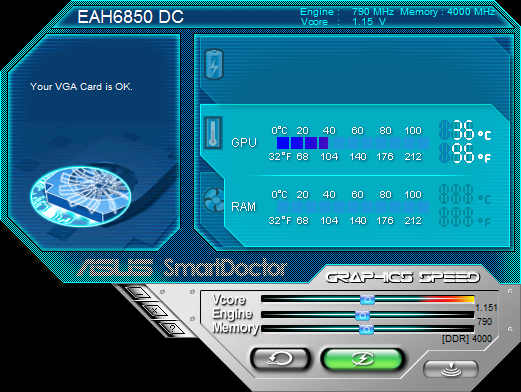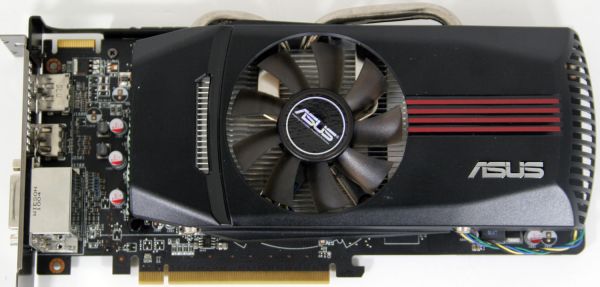AMD Radeon HD 6850 Overclocking Roundup: Asus, XFX, & MSI
by Ryan Smith on November 8, 2010 12:40 AM ESTMeet The Asus EAH6850
Our second card today is Asus’s first Radeon HD 6850, the EAH6850.The EAH6850 is the latest member in Asus’s Voltage Tweak subseries of cards, offering official voltage modification capabilities for overclocking through Asus’s SmartDoctor utility. It’s also the first overclocked card in today’s roundup, featuring a stock speed of 790MHz core and 1000MHz memory, a mere 15MHz over the 6850’s standard clocks. As a result the overclock is a token overclock at best - it’ll edge out stock-clocked cards in testing, but the difference is nothing to write home about.
In terms of design Asus has more or less completely thrown out the 6850 reference design for their own design. Starting with the PCB, Asus has gone with a custom PCB that runs a half-inch longer than the reference PCB, giving the EAH6850 a final length of 9.5”. With this extension Asus has moved the 6pin PCIe power socket to the top of the card, removing the need for additional clearance behind the card and in the process making the power socket much more accessible. Notably there’s a spot for a second power socket, and given the longer length of the card we wouldn’t be surprised if Asus ultimately released a 6870 using this PCB.
Meanwhile the component selection on the card is the usual mix of solid state capacitors and chokes. We haven’t been able to identify the VRM components in use, but we believe Asus is using a different VRM arrangement than on the reference 6850. The card also features a metal spine running down most the length of the card, providing the extra rigidity that a longer card requires and preventing it from significantly flexing.
Attached to the top of the card is the now customary Asus DirectCU cooler, Asus’s highly effective cooler which we have seen on a number of Asus cards in the past. This open-ended cooler uses a pair of aluminum heatpipes attached to a copper baseplate to transfer heat to the card’s aluminum heatsink, which runs roughly 2/3rds the length of the card. Embedded in the middle of the heatsink is the 70mm “dustproof” fan, and a partial shroud keeps airflow directed out the front and the rear of the card. Meanwhile the MOSFETs serving as part of the VRM circuitry have their own heatsink attached through springloaded clips, with airflow coming off of the fan keeping this second heatsink cool.
As is the case with the other partner cards in today’s roundup, Asus has ditched AMD’s 6800 series Eyefinity port configuration in favor of the 5800 series Eyefinity port configuration. This means the card has two DVI ports and the HDMI port along with one full-size DisplayPort, allowing the card to drive up to 5 monitors through a DP hub.

Because this is a Voltage Tweak card, Asus’s software plays an important role here by providing control for the card’s voltage modification capabilities. SmartDoctor has not changed since the last time we’ve seen it, providing a functionally competent but ultimately second-rate overclocking experience, as SmartDoctor lacks meaningful monitoring capabilities. Truth be told, the latest betas of MSI’s Afterburner software are able to program the EAH6850’s VRM controller, meaning there’s no practical reason to use SmartDoctor as the superior Afterburner is available.

As for pack-in items, Asus includes their usual collection for an AMD card: a quick-start manual, driver/utility CD, molex-to-PCIe power adaptor, short CrossFire bridge, a pleather CD binder, and a DVI-to-VGA dongle. Which on that note we had a chance to talk to Asus’s video card product manager last week and asked about the VGA dongle – it turns out that while VGA is largely dead & buried in North America, it’s alive and well in the Asia-Pacific region. Asus is simply packing their cards the same way in all regions, which means they all come with the VGA dongle.
Finally, the EAH6850 comes with Asus’s standard 3 year video card warranty. EAH6850 can be found for around $185, putting it at a $5 premium over AMD’s MSRP.


















93 Comments
View All Comments
tech6 - Monday, November 8, 2010 - link
Please don't feed the troll.haplo602 - Monday, November 8, 2010 - link
on the test setup page:Video Cards: AMD Radeon HD 6870
AMD Radeon HD 6850
AMD Radeon HD 5870
AMD Radeon HD 5850
AMD Radeon HD 5770
AMD Radeon HD 4870
NVIDIA GeForce GTX 480
NVIDIA GeForce GTX 470
NVIDIA GeForce GTX 460 1GB
NVIDIA GeForce GTX 460 768MB
>>>>>>>>>>>>>>> NVIDIA GeForce GTS 450 <<<<<<<<<<<<<<<
NVIDIA GeForce GTX 285
NVIDIA GeForce GTX 260 Core 216
XFX Radeon HD 6850
MSI R6850 OC
Asus EAH6850
However the card is nowhere in the graphs. Yet 5770 is there .... I was actualy interested in that comparison. thanks for the good work.
Ryan Smith - Monday, November 8, 2010 - link
I actually don't have the GTS 450 on the new test suite. We'll be updating Bench this next week, at which point it'll show up.Marburg U - Monday, November 8, 2010 - link
http://img838.imageshack.us/i/gpu46068706850ocstud...DoktorSleepless - Monday, November 8, 2010 - link
I would actually love to see the GTX 460 FTW in these charts because 850 mhz is a typical OC you can get from any regular GTX 460. The 460 and the 6850 are direct competitors so having both their overclock results side by side would be nice.kmmatney - Monday, November 8, 2010 - link
I have a HD4890, which is a power hog, yet I can run it at near silence, fully overclocked, with an Accelero S1 Rev 2 and a whisper fan. Too bad they don't offer a card with this sort of cooler pre-installed - then it would be possible to overclock these cards and still keep a quiet system. I wonder if this cooler will fit on these new cards? The cooler worked great onteh HD4890, but I did have to buy an extra heatsink for the VRMs (and had to hacksaw that to make it fit).Pantsu - Monday, November 8, 2010 - link
Can't the XFX cooler be adjusted with a tool like Afterburner? I mean that would solve the noise issue afaik. But if it's stuck that way there's no reason to buy it.casteve - Monday, November 8, 2010 - link
+1. Why not use Afterburner to remove some of the variables and see how the tested coolers stack up db vs temp?Oxford Guy - Sunday, November 14, 2010 - link
Yes.El_Capitan - Monday, November 8, 2010 - link
Newegg's Lowest prices (11/8/2010):HD 5870 1GB.................$299.99 (plus $2.99 shipping)
GTX 470 1.28GB............$249.99 (free shipping)
HD 6870 1GB.................$239.99 (plus $7.56 shipping)
HD 5850 1GB.................$239.99 (free shipping)
GTX 460 1GB..................$189.99 (plus $3.99 shipping)
HD 6850 1GB.................$179.99 (plus $7.56 shipping)
GTX 460 768MB.............$159.99 (free shipping)
GTS 450 1GB .................$109.99 (free shipping)
Just comparing the above, there's really two competitive ranges:
The $239.99 to $249.99 price range which includes the GTX 470 1.28GB, the HD 6870 1GB, and the HD 5850 1GB.
The $179.99 - $189.99 price range which includes the GTX 460 1GB, and the HD 6850 1GB.
How, if we're going by OVERCLOCKED comparisons for a SINGLE card, especially at the highest two resolutions (1920 x 1200 and 2560 x 1600):
1. The GTX 470 1.28GB overclocked definitely edges out both the overclocked HD 6870 1GB and HD 5850 in performance, while the HD 6870 1GB would be my pick over the HD 5850 1GB, both being the same price.
2. The GTX 460 1GB and the HD 6850 1GB are both great cards. However, seeing the Max Overclock for the HD 6850 with a Max Overclocked Voltage at 1.22v being 960MHz, and a Max Overclock witnessed for the GTX 460 1GB with a Max Overclocked Voltage at 1.087v being 1015MHz (most are in the 880MHz - 950MHz range), the GTX 460 1GB has a greater potential of overclocking ability than the HD 6850. Given that a GTX 460 1GB overclocked slightly betters that of a GTX 470 1.28GB at stock, the winner is obviously the GTX 460 1GB.
Please include the GTX 460 1GB overclocks when comparing overclocks with the HD 6850. Most of us are mature and smart enough to make our own decisions based upon test results, rather than guesswork. Those that are biased one way or another are going to believe what they want no matter what. All that we really losing out on, is our confidence that the site that's doing the review is behaving the same way. If we don't see it here, we're just going to go see it somewhere else.